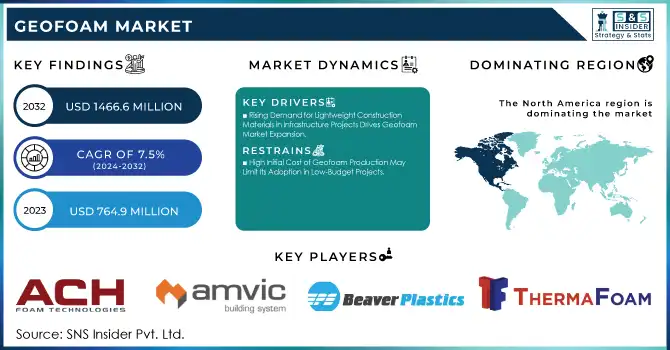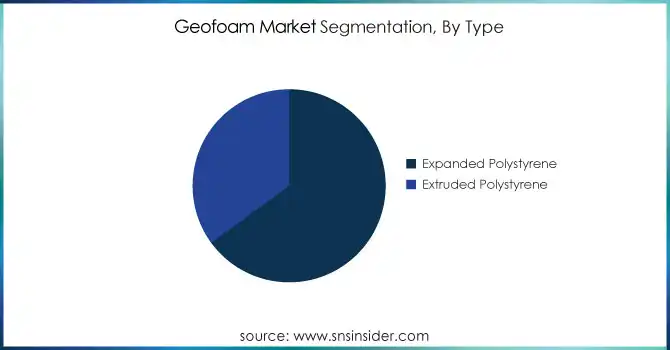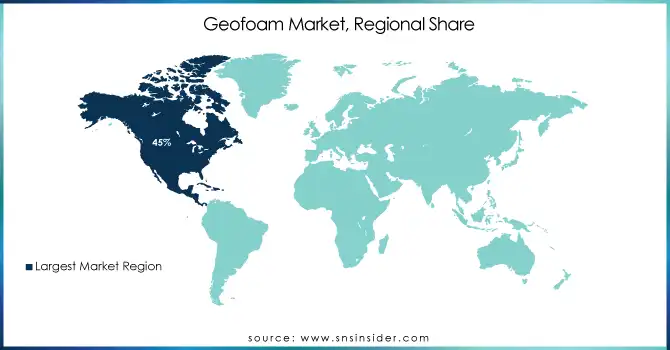Geofoam Market Report Scope & Overview:
The Geofoam Market Size was valued at USD 764.9 million in 2023 and is expected to reach USD 1466.6 million by 2032 and grow at a CAGR of 7.5% over the forecast period 2024-2032.

Get more information on Geofoam Market - Request Sample Report
The Geofoam market is witnessing significant growth, driven by the increasing demand for lightweight construction materials that offer excellent insulation properties. This demand is supported by various market dynamics, including the rising need for sustainable building practices, advancements in construction technologies, and a growing focus on infrastructure development across the globe. The versatility of Geofoam makes it suitable for numerous applications, such as road and highway construction, lightweight fill in buildings, and insulation in various civil engineering projects. As urbanization accelerates, the requirement for innovative solutions that can effectively manage soil stability and weight distribution becomes critical, further propelling the market's expansion.
Recent developments highlight the ongoing innovation within the Geofoam sector. In July 2024, an initiative was reported that focuses on protecting EPS Geofoam blocks using EIA geomembranes, enhancing their durability and performance in various applications. This advancement demonstrates a commitment to improving the longevity and environmental resilience of Geofoam materials. Additionally, in November 2024, the Department of Public Works and Highways announced the use of Geofoam for flyover repairs, citing its lightweight properties and effectiveness in reducing soil pressure. This strategic decision underscores the growing recognition of Geofoam's benefits in infrastructure projects. In another instance, the Indiana Department of Transportation incorporated Geofoam to stabilize the soil around the IND-252 interchange in May 2021, showcasing the material's utility in addressing engineering challenges while optimizing resource efficiency. These developments reflect a trend towards adopting innovative materials that align with contemporary engineering needs and environmental considerations, emphasizing the Geofoam market's potential for growth and adaptation in various applications.
Market Dynamics:
Drivers:
-
Rising Demand for Lightweight Construction Materials in Infrastructure Projects Drives Geofoam Market Expansion
The increasing demand for lightweight materials in infrastructure projects is one of the key drivers propelling the growth of the Geofoam market. In modern construction, particularly in areas with limited space or challenging soil conditions, Geofoam's lightweight nature offers a practical solution. Its use in roadways, bridges, and tunnels helps reduce the weight load on soil, making it ideal for projects that require soil stability without the excessive weight of traditional fill materials. Additionally, Geofoam’s lightweight properties also contribute to lower transportation costs, making it a cost-effective choice for large-scale infrastructure projects. In urban construction, where land is scarce and engineering challenges are high, Geofoam is gaining preference due to its ability to handle soil stability and drainage issues efficiently. Moreover, in transportation and construction of underground structures like metro systems, Geofoam helps prevent soil compaction, reducing construction time and costs. As urbanization increases and infrastructure demands rise, Geofoam's ability to address these specific engineering challenges, combined with its cost-effectiveness and ease of use, makes it a material of choice in the construction industry. This growing demand for lighter, more efficient building materials is expected to significantly drive the expansion of the Geofoam market in the coming years.
-
Increased Focus on Sustainable and Eco-Friendly Building Materials Supports Geofoam Market Growth
-
Growing Urbanization and Infrastructure Development Globally Boosts Demand for Geofoam Solutions
The rapid pace of urbanization and infrastructure development worldwide is a major driver of the Geofoam market. As cities expand and populations increase, there is a growing need for innovative solutions to manage construction challenges in dense urban environments. Geofoam, due to its lightweight and easy-to-install properties, is well-suited for infrastructure projects in such areas. It helps reduce the overall weight on structures while providing effective insulation and stability, making it a preferred material for projects involving bridges, roads, and tunnels. Additionally, as urban transportation networks such as metro systems and flyovers expand, Geofoam is increasingly being used in these projects to manage soil stability and ensure the longevity of structures. Its use in flyovers, highways, and underpasses helps mitigate challenges such as soil compression, making it ideal for congested urban areas where traditional construction materials would be difficult or costly to implement. Moreover, in regions facing the challenges of high seismic activity or heavy rainfall, Geofoam’s ability to provide lightweight support and reduce the risk of soil movement makes it an essential material for infrastructure development. The ongoing urbanization trend, particularly in emerging economies, will continue to boost the demand for Geofoam as a solution for efficient, cost-effective, and sustainable construction.
Restraint:
-
High Initial Cost of Geofoam Production May Limit Its Adoption in Low-Budget Projects
Opportunity:
-
Expanding Use of Geofoam in Landscaping and Environmental Applications Presents New Market Potential
The expanding use of Geofoam in landscaping and environmental applications presents a significant opportunity for market growth. Geofoam’s lightweight and insulating properties make it an ideal material for creating sustainable and efficient landscapes in urban environments. As cities and municipalities continue to focus on sustainable development and creating green spaces, Geofoam offers a solution that addresses both soil stability and environmental concerns. For example, in land reclamation projects or coastal erosion prevention, Geofoam can be used to provide support while preventing soil erosion, thus helping to protect delicate ecosystems. Its use in parks, gardens, and urban spaces allows for the construction of aesthetically pleasing landscapes while reducing the weight and load on the ground, making it a valuable material for green infrastructure projects. Furthermore, its ability to stabilize soil and reduce the need for heavy fill materials positions Geofoam as a viable solution in environmental engineering, where soil stabilization and sustainable development are critical. The growing emphasis on eco-friendly and low-impact construction methods is expected to drive demand for Geofoam in landscaping and environmental applications, opening up new markets and providing long-term growth potential.
-
Increasing Application of Geofoam in the Renewable Energy Sector Offers Growth Opportunities
-
Development of Geofoam for Advanced Engineering Solutions in Seismic Zones Unlocks New Potential
Geofoam’s potential for use in seismic zones presents an exciting growth opportunity. In regions prone to earthquakes, Geofoam’s lightweight and compressible properties help reduce the seismic load on buildings and infrastructure, making it an ideal material for earthquake-resistant construction. Geofoam acts as a buffer, absorbing seismic forces and preventing soil displacement during earthquakes, which is crucial for maintaining the stability of structures. As seismic activity increases in certain regions, the demand for materials that can mitigate seismic risk will rise, and Geofoam is well-positioned to meet this need. The use of Geofoam in earthquake-resistant construction projects, such as in building foundations, roadways, and bridges, will continue to grow, particularly in high-risk areas like Japan, California, and parts of South America. This opportunity for Geofoam to be incorporated into seismic engineering solutions not only enhances the safety and resilience of buildings but also provides manufacturers with new avenues for growth in a niche but essential market.
Evolving Customer Demographics and Demand Trends in the Geofoam Market
The Geofoam market is experiencing dynamic shifts driven by diverse customer demographics and emerging demand patterns across industries. Key trends include increasing demand from urban infrastructure projects, growing adoption in environmentally conscious construction, and preferences for lightweight and efficient materials in challenging terrains.
|
Customer Demographic |
Demand Trend |
|
Urban Infrastructure Developers |
High demand for Geofoam in metropolitan areas to support smart city projects and reduce soil loads. |
|
Sustainable Construction Advocates |
Growing preference for eco-friendly Geofoam products to align with green building certifications. |
|
Contractors in Seismic Zones |
Increased use of Geofoam for earthquake-resistant structures, focusing on safety and durability. |
|
Cold Climate Infrastructure Projects |
Rising demand for Geofoam in regions with permafrost due to its excellent insulation properties. |
|
Road and Highway Engineers |
Strong adoption in road embankments and slope stabilization to address challenging soil conditions. |
Urban infrastructure developers are leveraging Geofoam for lightweight solutions in high-density areas. Sustainable construction advocates are aligning with green building standards, driving demand for environmentally friendly Geofoam. Contractors in seismic zones value its properties for mitigating earthquake risks. Infrastructure projects in cold climates benefit from its insulation qualities, especially in permafrost regions. Road and highway engineers are increasingly adopting Geofoam to address challenges like soil instability and load reduction. These trends indicate Geofoam’s versatility and growing importance across diverse applications.
Key Market Segments
By Type
In 2023, the Expanded Polystyrene (EPS) segment dominated the Geofoam market with a market share of approximately 65%. EPS is favored in various construction applications due to its lightweight properties, excellent insulation capabilities, and cost-effectiveness. Its ability to reduce the load on soil makes it ideal for use in roadways, embankments, and structural foundations, where minimizing weight while providing stability is crucial. For instance, projects involving the construction of highways in areas with weak soil conditions often utilize EPS Geofoam to ensure soil stability without the added burden of heavy fill materials. Additionally, EPS's versatility and ease of installation further contribute to its popularity among contractors, solidifying its dominant position in the market.

By Application
In 2023, the Structure Foundation application segment dominated and accounted for the largest market share of about 40% in the Geofoam market. The need for stable and lightweight foundations in construction projects has made this segment particularly prominent. Geofoam is increasingly being used to stabilize foundations in both commercial and residential buildings, especially in regions with challenging soil conditions or seismic risks. For example, in urban areas where heavy fill materials can cause soil instability, Geofoam provides an effective solution by distributing weight evenly and minimizing settlement issues. Its application in structure foundations not only enhances the overall durability of buildings but also reduces construction time and costs, further driving its dominance in the market.
By End-Use
In 2023, the Building & Infrastructure end-use segment dominated the Geofoam market, capturing a market share of around 55%. This dominance is primarily driven by the rising need for sustainable construction materials and innovative solutions in the building sector. Geofoam is increasingly being integrated into various building applications, including foundations, wall systems, and roof insulation, due to its lightweight and insulating properties. For instance, in large-scale infrastructure projects such as bridges and tunnels, Geofoam is used to minimize the weight load on the underlying soil while providing excellent thermal insulation. As urbanization continues to rise globally, the demand for Geofoam in the building and infrastructure sector is expected to grow, further solidifying its leading position in the market.
Regional Analysis
In 2023, North America dominated the Geofoam market with a market share of approximately 45%. The region’s dominance can be attributed to the substantial demand for Geofoam in infrastructure projects, particularly in the United States and Canada. The U.S. has witnessed increased utilization of Geofoam in road and highway construction due to its ability to improve stability in areas with challenging soil conditions. For example, in states prone to expansive soils, such as California and Texas, the use of Geofoam in embankments and roadways significantly reduces the risk of soil instability and settlement. Furthermore, the growing emphasis on sustainable construction materials in the region has contributed to the market's growth, as Geofoam offers both lightweight and eco-friendly alternatives to traditional fill materials. Canada also plays a pivotal role, where infrastructure projects like bridges and tunnels in regions with permafrost conditions benefit from Geofoam’s thermal insulation properties. The extensive application across various sectors, including building and infrastructure, along with government initiatives promoting sustainable construction, has further solidified North America’s leadership in the Geofoam market.
Moreover, in 2023, Asia-Pacific emerged as the fastest-growing region in the Geofoam market, with a CAGR of 9%. This growth is primarily driven by the rapid urbanization and industrialization taking place in countries like China, India, and Japan, where construction activities have surged in recent years. China, in particular, is seeing a significant increase in infrastructure projects such as highways, railways, and urban construction, where Geofoam’s lightweight and insulation properties are being leveraged to reduce the load on soil and improve construction efficiency. In India, the growing demand for sustainable construction materials in both urban and rural areas has led to an increasing adoption of Geofoam, particularly in roadways and foundation applications. Japan’s advanced construction industry also relies on Geofoam in seismic-sensitive areas, where it helps mitigate the risks of soil settlement and structural damage during earthquakes. As the demand for infrastructure development continues to rise in these countries, the Asia-Pacific region is expected to maintain its rapid growth trajectory in the Geofoam market, driven by its rising adoption in key end-use sectors like road and highway construction, building & infrastructure, and airport runway construction.

Get Customized Report as per your Business Requirement - Request For Customized Report
Recent Developments
In 2023, Atlas Molded Products announced plans to expand its production capacity at its facilities in the United States. This initiative is fueled by the growing demand for Geofoam products in various construction applications, such as road and highway construction, building foundations, and slope stabilization.
Key Players
-
Atlas Molded Products (Elevation Geofoam Lightweight Fill)
-
Amvic Building Systems (Amvic Geofoam, Amvic Insulation)
-
Beaver Plastics (Beaver Foam Blocks, Beaver Geofoam)
-
Big Sky Insulations, Inc. (Geofoam Insulation, Lightweight Fill)
-
Carlisle Construction Materials (Carlisle Geofoam, Foam Insulation)
-
Expol Ltd. (Expol Geofoam, Expol EPS Geofoam)
-
Groupe Legerlite Inc. (Legerlite Geofoam, Lightweight Fill)
-
Harbor Foam Inc. (Geofoam Blocks, Geofoam Insulation)
-
Insulation Corporation of America (Geofoam, Expanded Polystyrene Foam)
-
Kaimann GmbH (Kaimann Geofoam, Thermal Insulation Foam)
-
Knauf Insulation (Knauf Geofoam, Thermal Insulation Panels)
-
L'Isolante K-Flex S.p.A (K-Flex Geofoam, K-Flex Insulation)
-
LiteForm Technologies, Inc. (LiteForm Geofoam, EPS Geofoam Blocks)
-
Morgan Advanced Materials (Geofoam Insulation, Polystyrene Foam Blocks)
-
Owens Corning (Owens Corning Geofoam, Foam Insulation Panels)
-
Porex Corporation (Porex Geofoam, High-Density Foam)
-
R-TECH (R-TECH Geofoam, Insulated Foam Products)
-
Securock (Securock Geofoam, Cementitious Geofoam)
-
ThermaFoam, LLC (ThermaFoam Geofoam, EPS Geofoam)
-
UFP Technologies (UFP Geofoam, EPS Geofoam Solutions)
| Report Attributes | Details |
|---|---|
| Market Size in 2023 | US$ 764.9 Million |
| Market Size by 2032 | US$ 1466.6 Million |
| CAGR | CAGR of 7.5% From 2024 to 2032 |
| Base Year | 2023 |
| Forecast Period | 2024-2032 |
| Historical Data | 2020-2022 |
| Report Scope & Coverage | Market Size, Segments Analysis, Competitive Landscape, Regional Analysis, DROC & SWOT Analysis, Forecast Outlook |
| Key Segments | •By Type (Expanded Polystyrene, Extruded Polystyrene) •By Application (Structure Foundation, Embankments, Slope Stabilization, Insulation, Retaining Structures, Others) •By End-Use (Road & Highway Construction, Building & Infrastructure, Airport Runway & Taxiways, Others) |
| Regional Analysis/Coverage | North America (US, Canada, Mexico), Europe (Eastern Europe [Poland, Romania, Hungary, Turkey, Rest of Eastern Europe] Western Europe] Germany, France, UK, Italy, Spain, Netherlands, Switzerland, Austria, Rest of Western Europe]), Asia Pacific (China, India, Japan, South Korea, Vietnam, Singapore, Australia, Rest of Asia Pacific), Middle East & Africa (Middle East [UAE, Egypt, Saudi Arabia, Qatar, Rest of Middle East], Africa [Nigeria, South Africa, Rest of Africa], Latin America (Brazil, Argentina, Colombia, Rest of Latin America) |
| Company Profiles | ThermaFoam, LLC, ACH Foam Technologies, LLC, Harbor Foam Inc., Amvic Building Systems, Insulation Corporation of America, Big Sky Insulations, Inc., Carlisle Construction Materials,Beaver Plastics, Groupe Legerlite Inc., Expol Ltd. and other key players |
| Key Drivers | •Increased Focus on Sustainable and Eco-Friendly Building Materials Supports Geofoam Market Growth •Growing Urbanization and Infrastructure Development Globally Boosts Demand for Geofoam Solutions |
| RESTRAINTS | •High Initial Cost of Geofoam Production May Limit Its Adoption in Low-Budget Projects |

